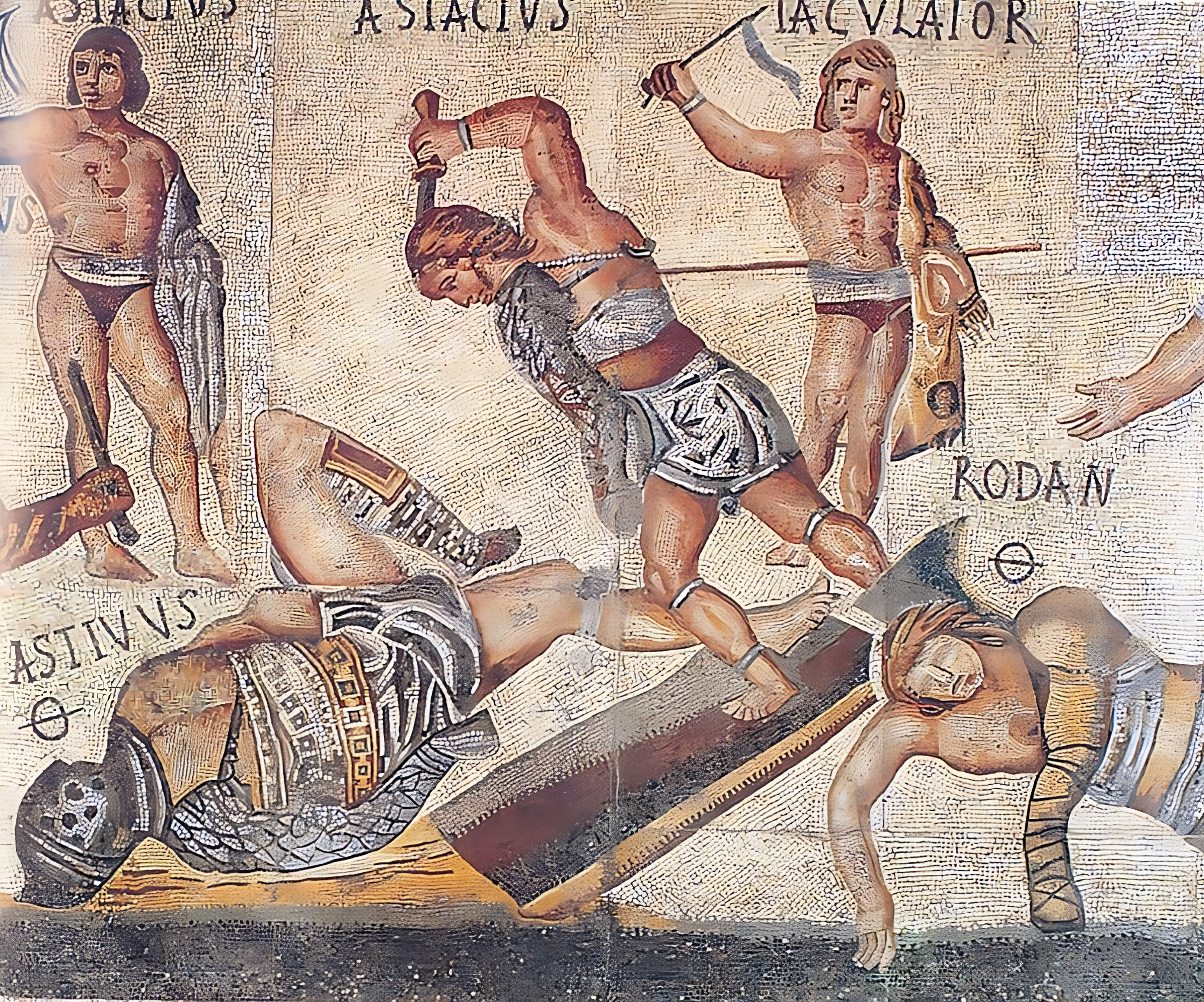Gladiator Mosaic on:
[Wikipedia]
[Google]
[Amazon]
 The Gladiator Mosaic'' is a famous set of 5 large
The Gladiator Mosaic'' is a famous set of 5 large

 The Gladiator Mosaic'' is a famous set of 5 large
The Gladiator Mosaic'' is a famous set of 5 large mosaic
A mosaic is a pattern or image made of small regular or irregular pieces of colored stone, glass or ceramic, held in place by plaster/mortar, and covering a surface. Mosaics are often used as floor and wall decoration, and were particularly pop ...
s of gladiator
A gladiator ( la, gladiator, "swordsman", from , "sword") was an armed combatant who entertained audiences in the Roman Republic and Roman Empire in violent confrontations with other gladiators, wild animals, and condemned criminals. Some gla ...
s and venators measuring about 28 meters, dated to the first half of the 4th century and installed in the Salone of the Galleria Borghese. It was discovered in 1834 on the Borghese
The House of Borghese is a princely family of Italian noble and papal background, originating as the Borghese or Borghesi in Siena, where they came to prominence in the 13th century and held offices under the ''commune''. During the 16th century, ...
estate at Torrenova
Torrenova ( Sicilian: ''Turrinova'') is a '' comune'' (municipality) in the Province of Messina in the Italian region Sicily, located about east of Palermo and about west of Messina. As of 31 December 2004, it had a population of 5,635 and an ...
, on the Via Casilina
The Via Casilina is a medieval road in Latium and Campania. It led from Rome to Casilinum (present-day Capua), to present-day Santa Maria Capua Vetere.
It was created from the fusion of two ancient Roman roads, the ''Via Latina'' and the '' Via La ...
outside Rome
, established_title = Founded
, established_date = 753 BC
, founder = King Romulus ( legendary)
, image_map = Map of comune of Rome (metropolitan city of Capital Rome, region Lazio, Italy).svg
, map_caption ...
. It is believed to have decorated a cryptoporticus of a large domus
In Ancient Rome, the ''domus'' (plural ''domūs'', genitive ''domūs'' or ''domī'') was the type of town house occupied by the upper classes and some wealthy freedmen during the Republican and Imperial eras. It was found in almost all the ma ...
. These antiquities reinvigorated the Borghese Collection after it had shrunk following the sale of much of the collection to Napoleon I
Napoleon Bonaparte ; it, Napoleone Bonaparte, ; co, Napulione Buonaparte. (born Napoleone Buonaparte; 15 August 1769 – 5 May 1821), later known by his regnal name Napoleon I, was a French military commander and political leader wh ...
.
The mosaic depicts a single narrative of gladiator fights and Venationes
Venatio ( la, venatio, "hunting", plural ''venationes'') was a type of entertainment in Roman amphitheaters involving the hunting and killing of wild animals.
History
Venatio was first introduced by Marcus Fulvius Nobilior, who celebrated his ...
. The name of each gladiator depicted is given in inscription next to the figure, some with the Greek letter Θ, an abbreviation for θάνατος "dead", for those who died in combat and others with vic t the Latin
Latin (, or , ) is a classical language belonging to the Italic languages, Italic branch of the Indo-European languages. Latin was originally a dialect spoken in the lower Tiber area (then known as Latium) around present-day Rome, but through ...
word for he wins, for the winners.
The inscription is listed as CIL VI 10206.
The mosaic is notable for its vivid depictions of the gladiators. The fight scene between Alumnus and the Secutor Mazicianus is notable for its decorative nature, Alumnus is showed wearing a multicolor sleeve and a subligaculum shaded with gray streaks. Another highly decorated fight scene can be seen between the retiarius
A ''retiarius'' (plural ''retiarii''; literally, "net-man" in Latin) was a Roman gladiator who fought with equipment styled on that of a fisherman: a weighted net (''rete'' (3rd decl.), hence the name), a three-pointed trident (''fuscina'' or ...
Licentious killing the gladiator Purpureus, where Licentious has long blonde hair and wears a belt
Belt may refer to:
Apparel
* Belt (clothing), a leather or fabric band worn around the waist
* Championship belt, a type of trophy used primarily in combat sports
* Colored belts, such as a black belt or red belt, worn by martial arts practiti ...
decorated with yellow and red triangles.
Inscription
:' :Astacius, Astivus, Rodan, Belleronfons, Cupido, Aurius, Alumnus, Serpeniius, Meliio, Mazicinus
References
Gladiatorial combat Borghese antiquities Late Roman Empire art Archaeological discoveries in Italy Roman mosaics 1834 archaeological discoveries {{decorative-art-stub